Legend has it that Harry Houdini died on Halloween in 1926 after an overeager fan punched him in the gut and caused his appendix to rupture — but the two events may not have been linked.
Harry Houdini defied the impossible throughout a mystifying career that still makes him a household name today. From swallowing needles a score at a time to pulling himself out of a whale carcass, to his famous “Chinese Water Torture Cell” escapes, Houdini dazzled millions with his stunts.
It seemed that death could never claim the famous magician, but Harry Houdini’s death did come on Halloween of 1926 — leaving behind mystery and speculation that has fascinated people ever since.
Harry Houdini’s Death-Defying Career
Harry Houdini was born on March 24, 1874, as Erik Weisz in Budapest, Hungary, and immigrated to the United States in 1878. Weisz started his career with stunts early, performing trapeze at age nine before beginning a Vaudeville career in magic in 1891.
He changed his name to Harry Houdini in honor of the famous French magician, Jean Eugène Robert-Houdin.
Houdini became known as the “handcuff king” and marveled audiences worldwide with the ability to escape from almost anything. His most famous escape was the “Chinese Water Torture Cell” in which an upside-down, suspended Houdini is lowered into then locked into a tank of water.
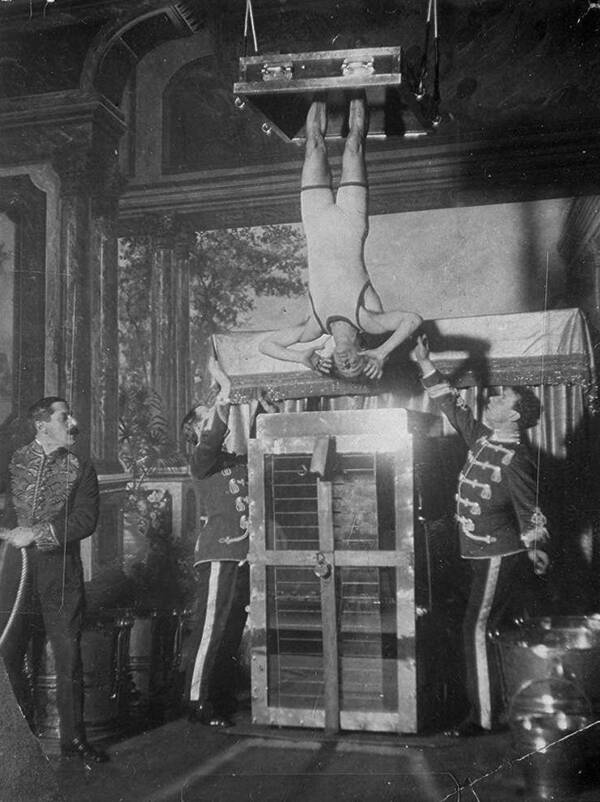
Wikimedia CommonsHarry Houdini performing the “Chinese Water Torture Cell” escape.
He was allowed two minutes to escape, which he invariably did to the delight of audiences. Houdini’s theatrics and charismatic persona seemed to be made for the burgeoning revolution of media in the early 20th century. He quickly rocketed to super-stardom.
Unexpected Body Blows
In 1926 at age 52, Harry Houdini was at the top of his game.
He toured the country in the early part of the year, performing escapes and enjoying his decades-old fame. But when he toured again that autumn, everything seemed to go wrong.
On October 11, Houdini broke his ankle while performing Water Torture Cell escape trick in Albany, New York. He managed to push through the next several appearances against doctor’s orders and then traveled to Montreal. There he made appearances at the Princess Theater and held a lecture at McGill University.
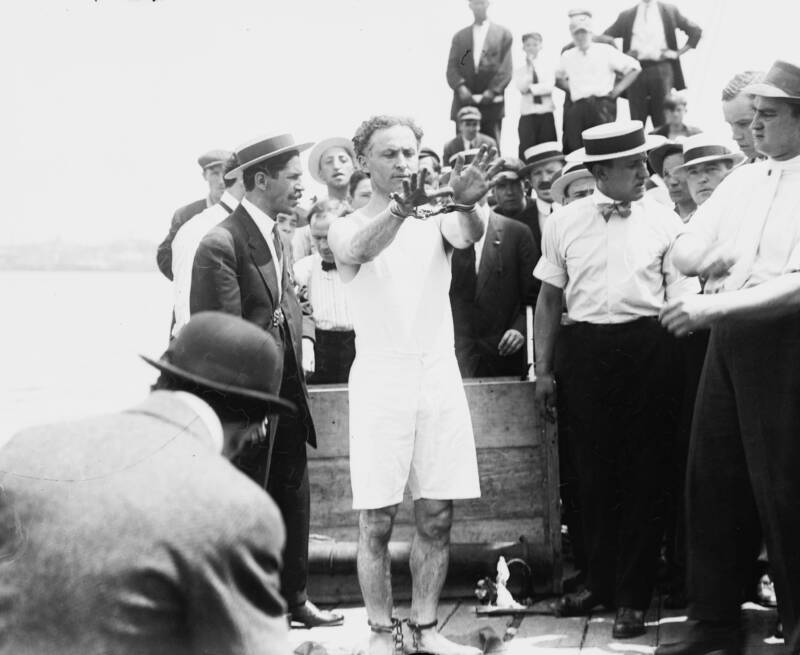
Wikimedia CommonsHarry Houdini prepares to escape from handcuffs — and a box thrown overboard a ship — in 1912.
After the lecture, he schmoozed with students and faculty, among them Samuel J. “Smiley” Smilovitch, who made a sketch of the famous magician. Houdini was so impressed with the drawing that he invited Smilovitch to come to the Princess Theater on Friday, October 22 to do a proper portrait.
On the appointed day at 11 a.m., Smilovitch came to visit Harry Houdini with a friend, Jack Price. They were later joined by a freshman student named Jocelyn Gordon Whitehead.
While Smilovitch sketched Houdini, Whitehead chatted with the magician. After some talk about Houdini’s physical strength, Whitehead asked if it was true that he could withstand even the mightiest punch to the stomach. Jack Price then recalled the following as was recorded in Ruth Brandon’s book, The Life and Many Deaths of Harry Houdini:
“Houdini remarked rather unenthusiastically that his stomach could resist much….Thereupon he [Whitehead] gave Houdini some very hammer-like blows below the belt, first securing Houdini’s permission to strike him. Houdini was reclining at the time with his right side nearest Whitehead, and the said student was more or less bending over him.”
Whitehead struck at least four times until Houdini gestured him to stop in mid-punch. Price recalled that Houdini, “looked as though he was in extreme pain and winced as each blow was struck.”
Houdini said that he didn’t think Whitehead would strike so suddenly, otherwise he would have been better prepared.
By evening, Houdini was suffering tremendous pain in his abdomen.
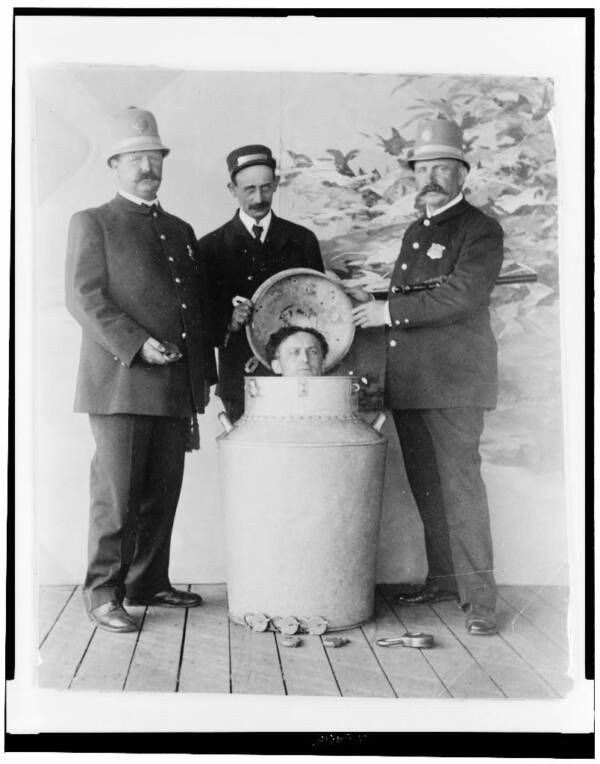
Library of CongressOne of Harry Houdini’s tricks was escaping from a milk can.
The Last Performance
The next evening, Houdini left Montreal on an overnight train to Detroit, Michigan. He telegraphed ahead for a doctor to examine him.
The doctor diagnosed Houdini with acute appendicitis and said he should go immediately the hospital. But the Garrick Theater in Detroit had already sold $15,000 worth of tickets for that evening’s show. Houdini reportedly said, “I’ll do this show if it’s my last.”
Houdini carried on with the show at the Garrick on October 24, despite having a temperature of 104°F. Between the first and second acts, ice packs were used to cool him down.
According to some reports, he passed out during the performance. By the beginning of the third act, he called off the show. Houdini still refused to go to the hospital until his wife forced him.
A hotel physician was called, followed by his personal physician, who convinced him to go to Grace Hospital at 3 a.m.
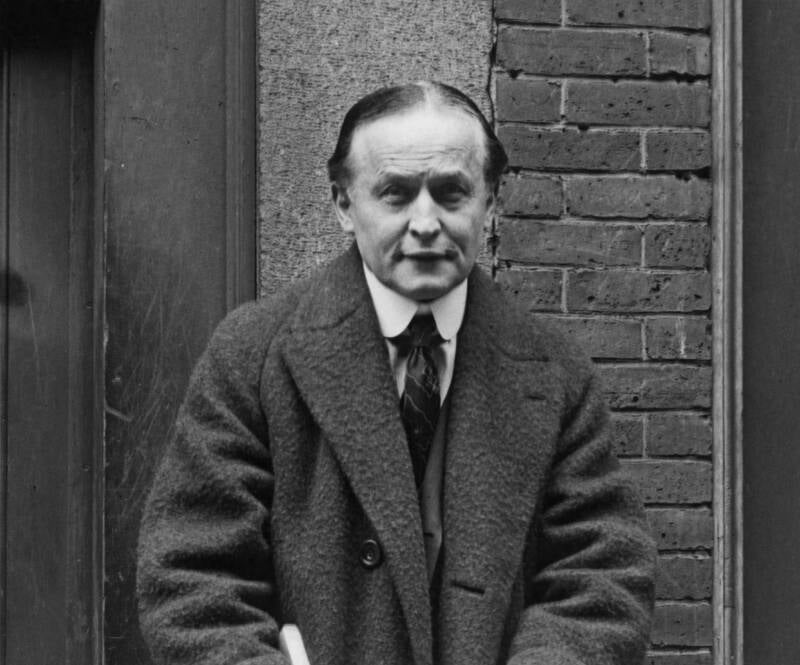
Pictorial Parade/Archive Photos/Getty ImagesHarry Houdini c. 1925, a year before he died.
Harry Houdini’s Death
Surgeons removed Harry Houdini’s appendix on the afternoon of October 25, but because he had delayed treatment for so long, his appendix had ruptured and the lining of his stomach was inflamed with peritonitis.
Infection spread throughout his body. Today, such a malady simply requires a round of antibiotics. But this was 1926; antibiotics wouldn’t be discovered for another three years. Houdini’s bowels became paralyzed and surgery was needed.
Houdini received two operations, and he was injected with an experimental anti-streptococcal serum.
He seemed to recover somewhat, but he quickly relapsed, overcome by sepsis. At 1:26 p.m. on Halloween, Harry Houdini died in his wife Bess’s arms. His last words were supposedly, “I’m getting tired and I can’t fight any more.”
Houdini was buried at Machpelah Cemetery, a Jewish graveyard in Queens, with 2,000 mourners wishing him well.

Wikimedia CommonsHarry Houdini’s grave in New York.
Harry Houdini And Spiritualism
Surrounding Harry Houdini’s death was a wild subplot involving spirits, séances, and a ghost named Walter. And for any of that to make sense, we need to circle back to Houdini’s life and another one of his pet passions: debunking Spiritualism.
More than a performer, Houdini was an engineer to the bone.
Houdini performed tricks onstage, but he never played them off as “magic” — they were simply illusions. He made his own equipment to suit the specific needs of his tricks, and performed them with the necessary pizazz and physical strength to wow an audience. They were feats of engineering masquerading as entertainment.
And that’s why he had a bone to pick with Spiritualism.
The religion, which was based on the belief that it’s possible to communicate with the dead, reached its peak popularity in the 1920s. World War I had just killed 16 million people across the globe, and the Spanish flu pandemic of 1918 had wiped out 50 million more. The world was traumatized by death, and a religious movement that purported to keep the dead somewhat alive was attractive, to say the least.
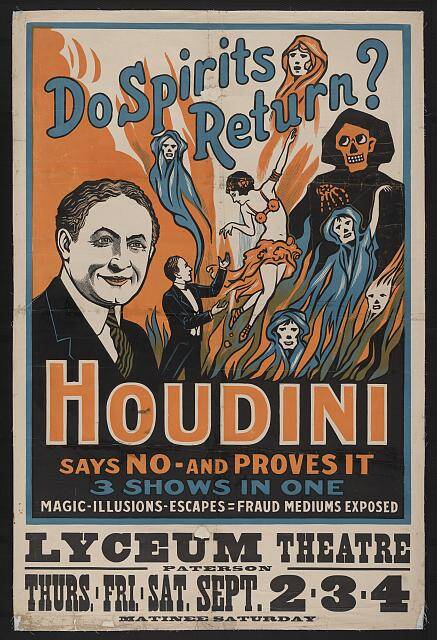
Library of CongressA Houdini show poster emphasizing his debunking efforts against spiritual mediums.
But with the movement came an influx of “mediums,” people who became celebrities for their supposed ability to communicate with the deceased. They employed all sorts of tricks to dupe people into thinking they had supernatural abilities, and Houdini couldn’t stand it.
And so, in his several decades on Earth, he made it his mission to expose the mass movement for what it was: a sham.
In one of his most famous anti-Spiritualism escapades, Houdini attended two séances with Boston medium Mina Crandon, known to her followers as “Margery,” who claimed to be able to conjure the voice of her dead brother, Walter.
Crandon was up for a $2,500 prize if she could prove her powers to a six-person committee of respected scientists from Harvard, MIT, and elsewhere. Intent on keeping her from winning the prize money, Houdini attended Crandon’s séances in the summer of 1924, and was able to deduce how she performed her tricks — a mix of distractions and contraptions, it turns out.
He recorded his findings in a pamphlet, complete with drawings of how he believed her tricks worked, and even performed them for his own audiences to much laughter.
Crandon’s supporters would have none of it, and in August 1926, Walter proclaimed that “Houdini will be gone by Halloween.”
Which, as we know, he was.
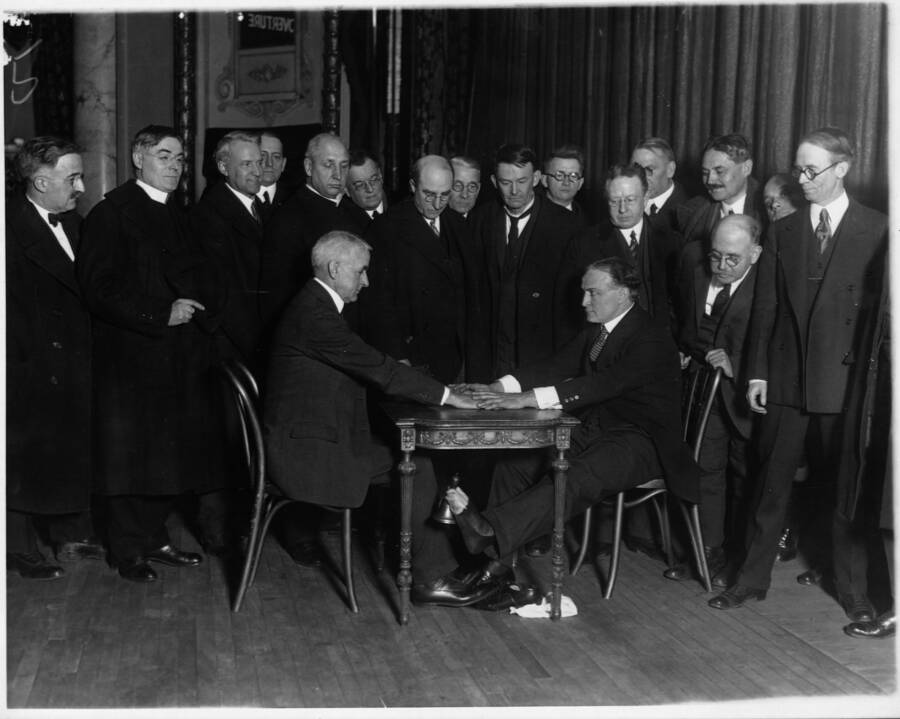
Library of Congress/Corbis/VCG/Getty ImagesHarry Houdini demonstrates how, during a séance, mediums can ring bells using their toes.
Harry Houdini’s Death: A Spiritualist Plot?
To spiritualists, the concurrence of Walter’s prediction and Harry Houdini’s death proved their religion. To others, it fueled a conspiracy theory that spiritualists were to blame for the illusionist’s demise — that Houdini had actually been poisoned, and that Whitehead was in on it. But there’s no evidence for this.
Ironically, though he was an anti-spiritualist, Harry Houdini’s death became fuel for spiritualist fodder.
He and his wife, Bess, had made a pact that whichever one of them died first would try to communicate with the other from the great beyond, to prove once and for all whether Spiritualism was real.
And so Bess held a séance on the next nine Halloween nights, trying to conjure up the spirit of her husband. In 1936, 10 years after Harry Houdini’s, Bess held a much-anticipated “Final Séance” in the Hollywood hills. Her husband never showed.
“Houdini did not come through,” she declared:
“My last hope is gone. I do not believe that Houdini can come back to me, or to anyone. After faithfully following through the Houdini ten year compact, after using every type of medium and seance, it is now my personal and positive belief that spirit communication in any form is impossible. I do not believe that ghosts or spirits exist. The Houdini shrine has burned for ten years. I now reverently turn out the light. It is finished. Good night, Harry.”
Bess may have abandoned her pursuit to communicate with Harry Houdini after he died, but the public hasn’t: Every Halloween, you’re bound to find a group of ouija board enthusiasts trying to conjure the spirit of the long-lost illusionist.
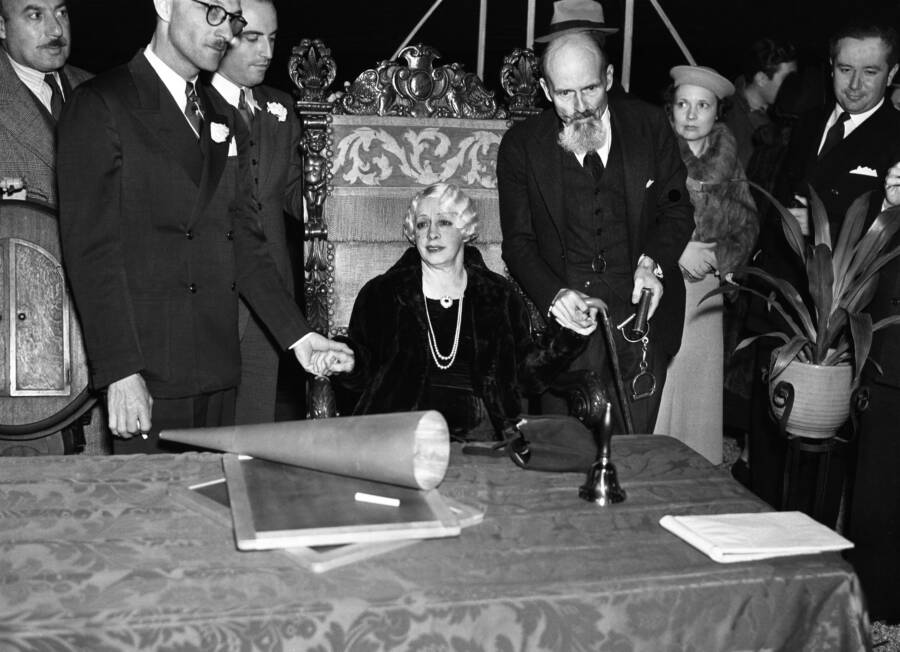
Bettmann/Getty ImagesIn her tenth and last experiment to contact her late husband, Bess Houdini conducted a séance in Los Angeles. Here, she is with Dr. Edward Saint, who is holding a pair of handcuffs. The late Houdini was the only one who knew the combination to unlock them.
“They usually form a circle, hold hands and say they are friends of Houdini’s,” said one amateur magician who attended a séance in 1940s New York City. “They ask for some sign that he can hear them. Then they wait five minutes or half an hour and nothing happens.”
How Did Harry Houdini Really Die?
The question is whether there was a causal link between Whitehead’s blows and Harry Houdini’s ruptured organ.
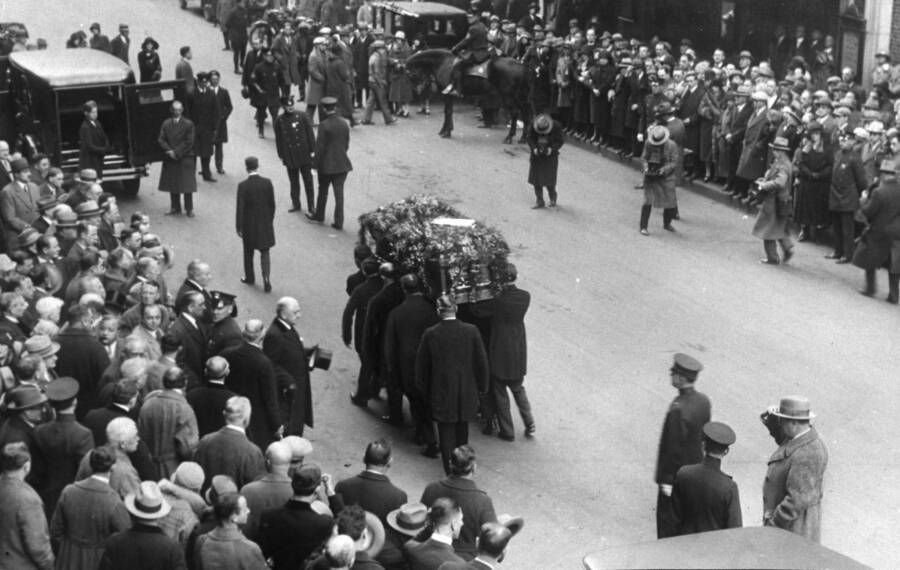
NY Daily News Archive/Getty ImagesHarry Houdini’s casket is carried to a hearse while thousands of fans look on in New York City. Nov. 4, 1926.
In 1926, blows to the abdomen were thought to cause a ruptured appendix. Today, however, the medical community considers such a link very much up for debate. It’s possible that the punches led to Houdini’s appendicitis, but it’s also possible that the two events just so happened to coincide.
The weight of evidence suggests a mundane cause of death for the mystifying magician — but Harry Houdini certainly knew how to make the mundane dramatic.
After learning how Harry Houdini died, read about the seven strangest celebrity deaths of the 1920s. Then, these five magic tricks proved deadly.






